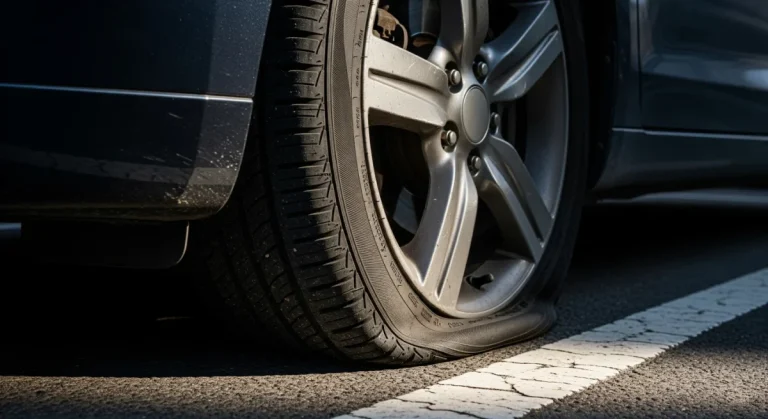How Much Does a Car Battery Weigh? A Complete
Key Takeaways
- Average Weight: A standard car battery weighs between 30 and 50 pounds (13.6 to 22.7 kg).
- Primary Factor: The weight is primarily due to the heavy lead plates and sulfuric acid electrolyte inside traditional lead-acid batteries.
- Weight Varies: The exact weight depends on the battery’s type (Lead-Acid, AGM, Lithium), its BCI group size, and its capacity (Ah).
- Lighter Alternatives: Modern Lithium (LiFePO4) batteries are a significantly lighter alternative, often weighing 50-70% less, but come at a higher cost.
- Safety First: Due to their awkward shape and weight, always use proper lifting techniques to avoid back injury when handling a car battery.
If you’ve ever tried to lift a car battery, you know it’s surprisingly heavy for its size. You might be planning a replacement, moving a dead battery, or you’re simply curious about why this essential component weighs so much. While the question “how much does a car battery weigh?” seems simple, the answer has a few important layers.
This guide provides more than just a number. We’ll break down exactly why your battery is so heavy and provide a detailed chart to find your battery’s specific weight. Most importantly, we’ll give you practical advice for handling one safely and confidently.
What Factors Determine a Car Battery’s Weight?
A car battery’s weight isn’t arbitrary. It’s a direct result of its internal chemistry and construction, which are designed to deliver a massive amount of power in a short burst to start your engine. Here are the main factors that determine its final weight.
Battery Type: The Biggest Influence
- Lead-Acid & AGM: The vast majority of cars use a lead-acid battery. Their immense weight comes from a simple formula: dense lead plates submerged in a liquid electrolyte made of sulfuric acid and water. An AGM (Absorbent Glass Mat) battery is a type of lead-acid battery where the electrolyte is absorbed into fiberglass mats, making it spill-proof, but it is still fundamentally heavy.
- Lithium (LiFePO4): These are the modern, lightweight challengers. Using lithium iron phosphate chemistry, these batteries are significantly lighter than their lead-acid counterparts while offering the same power. We’ll compare them directly in a later section.
BCI Group Size: Standardizing Dimensions and Weight
You will find a “group size” number on your battery’s label, such as “Group 35” or “Group 65”. This code is a standard set by the Battery Council International (BCI) that defines the battery’s exact physical dimensions, terminal placement, and mounting style. Because a larger group size means a physically bigger battery with more internal components, it almost always means a heavier battery.
Capacity (Ah) and Power (CCA)
A battery’s capacity, measured in Ampere-hours (Ah), and its starting power, measured in Cold Cranking Amps (CCA), also affect its weight. A battery with higher capacity and more starting power needs more lead plates and electrolyte inside. Consequently, more power equals more weight.
Vehicle Application: Car vs. Truck Batteries
It stands to reason that a large V8 truck requires more power to start than a small 4-cylinder sedan. Therefore, batteries designed for trucks and large SUVs are typically in larger BCI group sizes. This makes them more powerful and noticeably heavier than those for compact cars.
Car Battery Weight Chart by Common BCI Group Size
To get a precise idea of your battery’s weight, you first need to identify its BCI group size, which is always printed on the top or side label. This chart provides the average weight ranges for common group sizes in both pounds and kilograms.
Disclaimer: These are typical industry averages. The exact weight can vary slightly by manufacturer and specific type (AGM vs. standard flooded lead-acid).
| BCI Group Size | Common Vehicle Types | Avg. Lead-Acid Weight (lbs) | Avg. Lead-Acid Weight (kg) |
|---|---|---|---|
| 51R | Honda Civic, Toyota Prius | 28 – 35 lbs | 12.7 – 15.9 kg |
| 35 | Toyota Camry, Subaru Outback | 35 – 44 lbs | 15.9 – 20.0 kg |
| 24/24F | Toyota Highlander, Lexus RX | 40 – 51 lbs | 18.1 – 23.1 kg |
| 65 | Ford F-150, Dodge Ram | 45 – 55 lbs | 20.4 – 24.9 kg |
| 48 (H6) | GM, VW, BMW, Mercedes | 45 – 55 lbs | 20.4 – 24.9 kg |
| 94R (H7) | Audi, BMW, Mercedes | 50 – 60 lbs | 22.7 – 27.2 kg |
Is a Car Battery Too Heavy to Lift? Safety & Handling Tips
For many people, a 40- or 50-pound object can be difficult to manage, especially when you’re leaning over into a cramped engine bay. A car battery’s compact size makes it deceptive, and its weight can easily lead to a back strain if you lift it improperly.
The Right Way to Lift a Car Battery
I’ll never forget the first time I changed a battery myself in Multan. I just bent over and tried to yank it out—my back was sore for two days. I learned my lesson, and now I always follow these simple steps:
- First, get as close to the battery as possible.
- Second, bend at your knees and keep your back straight. Do not bend at the waist.
- Next, get a firm grip on the battery’s handle or its sides.
- Then, lift smoothly with your leg muscles, not your back.
- Finally, keep the battery level as you carry it, especially if it’s a non-sealed type, to prevent acid spills.
Tools That Help: Battery Straps and Carriers
For just a few dollars, you can buy a battery lifting strap or carrier. These simple tools wrap around the battery, giving you a secure, ergonomic handle. This makes the task much safer and is a worthwhile investment if you plan to do your own car maintenance.
The Lightweight Alternative: Lithium (LiFePO4) Car Batteries
If you’re looking for a modern, high-performance option, lithium starter batteries are a game-changer, especially regarding weight.
Head-to-Head Weight Comparison
A LiFePO4 (Lithium Iron Phosphate) battery is typically 50-70% lighter than a lead-acid battery with the same power rating. This is a massive difference you can feel immediately. For instance, a heavy 45-pound lead-acid battery can often be replaced by a lithium version that weighs only 15 pounds.
Beyond Weight: The Pros and Cons of Lithium
This weight reduction is a huge benefit, but it’s important to be transparent about the trade-offs. Lithium batteries also offer a much longer lifespan and can improve starting performance. However, their primary drawback is a significantly higher upfront cost, often several times that of a traditional AGM battery.
Conclusion: The Final Weigh-In
A typical car battery weighs between 30 and 50 pounds, a direct result of its heavy lead-acid chemistry. The specific weight depends on its size and type, but one thing is constant: it’s an awkward, dense object that demands respect.
By using a weight chart and, more importantly, proper lifting techniques, you can handle a battery replacement safely and confidently. Understanding your car battery’s weight is the first step to mastering the task.
Frequently Asked Questions (FAQ)
How heavy is a car battery in kg?
An average car battery weighs between 13.6 and 22.7 kilograms. Lighter batteries for small cars can be around 13 kg, while heavier batteries for trucks can exceed 25 kg.
Is a car battery heavy to carry?
Yes, for most people, a car battery is considered heavy and awkward to carry. Their weight (30-50 lbs) combined with their compact shape and the often-cramped location in an engine bay, can make them difficult to lift without proper technique, posing a risk of back strain.
Does a dead car battery weigh more than a charged one?
No, a dead battery does not weigh more or less than a charged one. The process of discharging and recharging is a chemical reaction where atoms are rearranged internally, but no mass is lost or gained from the battery itself. The weight remains constant.
Why are car batteries so heavy?
Car batteries are heavy because their primary components are lead plates and a sulfuric acid solution. Lead is an extremely dense metal, so even a small battery requires a significant amount of it to generate the power needed to start an engine, resulting in a high overall weight.
How much does a Tesla or EV battery weigh?
This is a common point of confusion. The large, high-voltage battery pack that powers an electric vehicle (EV) is extremely heavy, often weighing between 1,000 and 1,200 pounds (about 450-540 kg). However, EVs also have a small, separate 12-volt battery for accessories, which weighs the same as a normal car battery (30-40 lbs).






